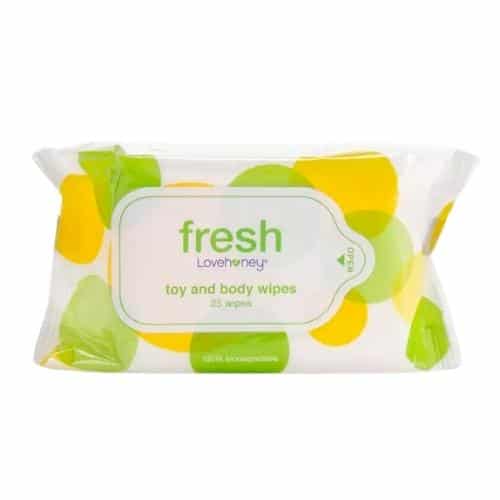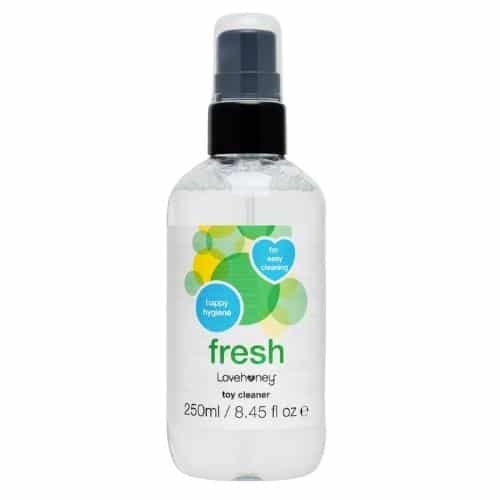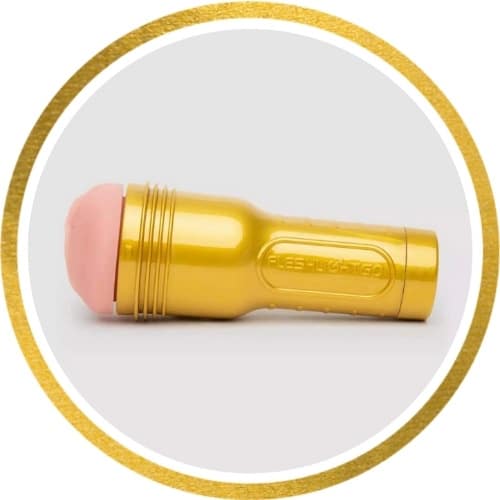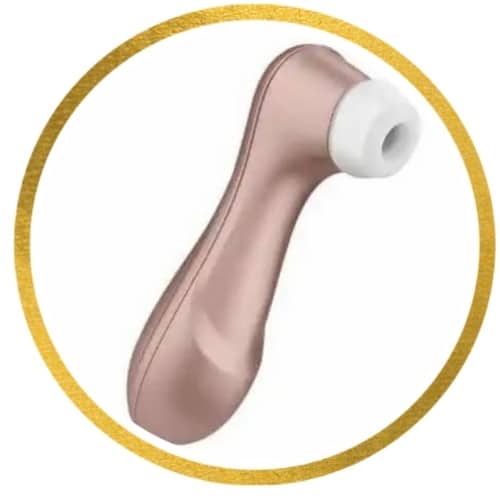![How to Clean Sex Toys [The Ultimate Guide]](https://wp.bedbible.com/wp-content/uploads/2024/07/How-to-clean-your-sex-toys.png)
Part of being the owner of a large and beautiful collection of sex toys is learning how to clean them all.
In an ideal world, I would love to be able to snap my fingers and have the dildo-cleaning fairies take care of it all.
However, back here on Earth, I’ll settle with doing it myself.
And the good news is: it’s not that hard to clean your sex toys.
We’ve written a lot about how to take care of different sex toys, but in this post, we’ve collected all our advice together into one ultimate sex toy cleaning guide!
Check our YouTube video if you want to watch a video instead: https://www.youtube.com/watch?v=QNXl-Y1Bypc&ab_channel=BedBible
Table of contents:
- Why clean your sex toys?
- TLDR: Infographic on how to clean your toys
- What you need for cleaning
- What are Your Sex Toys Made From?
- How to Clean a Dildo
- How to Clean a Vibrator
- How to Clean Anal Toys
- How to Clean a Strap-On
- How to Clean a Fleshlight
- How to Clean a Sex Doll
- Guide to Sterilizing Sex Toys
- Cleaning Sex Toys With a Dishwasher
Why clean your sex toys?
Cleaning your sex toys after every use is so, so important. Not only does it stop bacteria, viruses, fungi, and other germs from coming into contact with your genitals (and the rest of your body), but it also extends the life of your toys. A good-quality, well-taken-care-of toy can give you many years of pleasure!
TLDR: Infographic on how to clean your toys
Using the below infographic, you can find the cleaning method best suited for your type of toy.
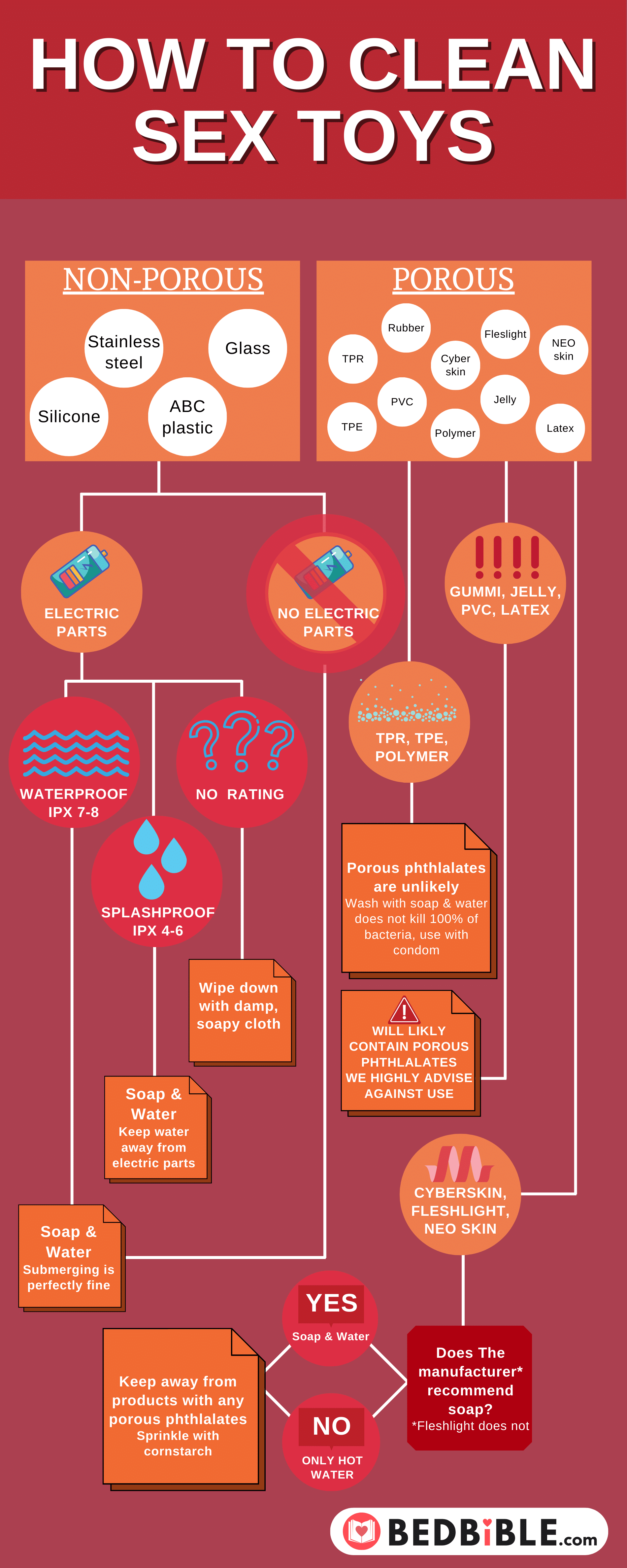
Put in a table
| Material | Cleaning Method |
|---|---|
| ABS plastic | Warm water and soap or sex toy cleaner |
| Crystal, Stone | Warm water and soap |
| Glass, Pyrex, Silicone, Stainless Steel | Motorized: warm water and soap or sex toy cleaner Nonmotorized: boiling water or sanitizing in the dishwasher |
| Jelly Rubber, Elastomer, Latex, Cyberskin, PVC | Room temperature water and a soapy washcloth |
| Leather | Spot clean with a damp, soapy cloth |
What you need for cleaning
Here is a short list of the tools and things you need to clean your sex toys properly:
For Surface Cleaning
- You will need water. Either room temperature or warm (pre-boiled, not from the tap).
- Use soap: Liquid hand soap or castile soap is preferred. While antibacterial soap is acceptable, it is not necessary. It’s important to avoid using harsh soaps like dish soap.
- Have paper towels or clean washcloths on hand for air-drying toys after cleaning.
For Deep Cleaning
- Prepare a pot for boiling water: You can effectively disinfect various toys by first surface-cleaning them and then submerging them in boiling water for just a few minutes.
- Gather bleach and a spray bottle (or another container for a bleach solution): Boiling and using a bleach solution will eliminate most, though not all, pathogens on your toys.
- Consider using a dishwasher: Ensure your dishwasher has appropriate settings for disinfection. If not, it’s advisable to use boiling water or a bleach solution.
- Keep paper towels or clean washcloths ready for air-drying toys after cleaning.
Optional
- Consider sex-toy wipes or cleaning sprays, though in most cases, plain soap and water are sufficient for cleaning purposes.
What are Your Sex Toys Made From?
I have good news for you: most sex toy cleaning techniques are the same, no matter what kind of sex toys you own!
That’s because how you clean your sex toys actually depends much more on the materials they’re made out of. Whether you have a vibrator, a butt plug, or a Fleshlight — take a look at what your sex toy is made from (not just what you think it might be), and go from there.
In general, we split sex toy materials into two categories: porous and non-porous.
| Porous | Non-Porous |
|---|---|
| PVC | Silicone |
| TPE/TPR | ABS Plastic |
| Other Soft Plastics | Glass |
| Jelly | Steel |
| Vinyl | Wood (when sealed with body-safe sealant) |
| Rubber | Porcelain |
| Latex | |
| Silicone ‘blends’ (that aren’t 100% silicone) | |
| Most crystals |
Here at Bedbible, we recommend you stick to non-porous materials wherever possible. They’re safe to be used in your body, and much easier to clean.
Porous materials, on the other hand, aren’t so body-safe.
They have microscopic holes all over the surface that can trap dirt and germs like bacteria, fungi and more — stuff you don’t really want anywhere near your genitals!
Some even contain toxic substances, like phthalates, which have been linked to cancer.
It’s important to note, though, that not all porous materials are evil.
Many can be used externally without damaging your body, in penis strokers and nipple toys, for instance.
Just be aware that they are a lower quality material that requires thorough cleaning, and will most likely degrade quicker than sex toys made from non-porous materials.
How to Clean a Dildo
Dildos are one of the easiest sex toys to clean! Still, you must clean them properly and thoroughly, since they’re going inside you.
TLDR: A quick guide to cleaning a dildo
Most dildos can be cleaned with some simple soap and water. Take a mild, unscented soap and lather up your dildo using some warm water. Make sure to get into all the textures and crevices!
Avoid soaps with fragrances, moisturizers, or essential oils, as these can leave a residue on your dildo that you don’t want to end up inside of you (if you want to avoid a bacterial or yeast infection). Similarly, avoid soaps with exfoliants, as they’ll scratch the surface of your dildo and create hiding places for germs.
If you prefer, you can use a toy cleaner instead. There are lots of different ones available, but one of our favorites is the Fresh Toy Cleaner spray from Lovehoney.
Silicone, steel, and glass dildos can also be sterilized by boiling them or putting them in the dishwasher, as long as they don’t contain any electrical parts.
Soap and Water
Luckily for most of us, finding out how to clean a dildo properly doesn’t require anything more than what you already have in your bathroom.
The easiest way to clean a dildo is with good old soap and water. Take a mild and unscented soap and lather up your dildo with it. Once you’ve got into all the grooves and crevices, rinse it off thoroughly with water, pat dry with a clean towel and you’re done!
However, don’t reach for that super creamy, lovely lavender hand soap just yet.
You should avoid using scented soaps, or ones with additives like moisturizers or exfoliants in them, as they can affect the pH balance of your genitals (especially if you have a vagina). This can lead to problems like bacterial or yeast infections – and I’m sure I don’t have to tell you that those aren’t worth the trip to the Dollar Store you saved.
Of course, if your dildo isn’t waterproof, you should keep it away from water, which can be the case if it is a vibrating dildo or a thrusting dildo.
As an alternative, you can apply some soap to a damp cloth and wipe down your dildo well, before wiping it again with a clean cloth and drying it thoroughly.
Sex Toy Cleaner
The other way to clean a dildo that you may have heard of is by using a sex toy cleaner. These come in many different forms, including sprays, gels, foams, and even wipes.
If you’re lucky, your new dildo may come with its little packet of branded sex toy cleaner, but as a general rule, dildos can be cleaned with any good quality sex toy cleaner.
Using one is pretty similar to using soap and water.
All you need to do it apply it to your dildo, leave it on for as long is it says on the packaging, and then rinse or wipe off the excess.
There is but one potential hitch: there’s some debate as to how effective sex toy cleaners can be if they’re not rinsed off properly.
They may not catch absolutely all the nasty stuff, so it can be a good idea to use them as a ‘sometimes’ solution to cleaning your dildo, alongside washing them thoroughly with soap and water.
The Dishwasher
It’s time for the namesake of this blog post: how to clean your dildo in the dishwasher!
Let me preface this by saying that you can only put dildos in the dishwasher that are made of non-porous materials and do not contain any electrical parts!
Subjecting a dildo made of PVC, jelly or any other porous material to the high temperatures of a dishwasher will destroy it, no questions asked. You should also avoid putting natural stone dildos into the dishwasher, as they can contain tiny fissures that may cause them to explode!
To clean your dildos in the dishwasher, place them on the top rack of your otherwise empty dishwasher. Don’t add any detergent or soap, as it can leave a residue and harm your genitals.
If your dishwasher has a ‘sanitize’ function, select that to make sure that all bacteria remaining on your dildos are killed. Otherwise, use a cycle that lasts for 5-10 minutes and reaches at least 150ºF – though not longer, as your dildos aren’t dishes and don’t need it.
Sex Toy Soup
Sounds gross, I know, but this soup is not for consumption.
‘Sex toy soup’ is a phrase used a lot to describe the method of boiling your sex toys in a pot of water to clean them. This is a quick and easy alternative to putting them in the dishwasher and achieves the same goal of sanitizing them.
Simply boil a large pot of water (in a clean pot), with no soap or other additives, and then submerge your dildos for 1-3 minutes. If you’re boiling dildos made from stainless steel or borosilicate glass, you can place a washcloth in the pot first, or place them in a mesh laundry bag to protect them and the pot as they bounce around in the boiling water.
This can be a great solution for sanitizing some kinds of dildos, but you should be sure to take the same precautions and avoid boiling some materials as with the dishwasher method.
How NOT to Clean a Dildo
It doesn’t take much Googling to find a lot of contradictory or just plain confusing advice on how to clean a dildo or any other sex toy. You can find a huge number of articles recommending all kinds of ways to clean and disinfect sex toys, but don’t be fooled – many of them are inadvisable, or even downright dangerous!
Here’s a simple rule to keep in mind: don’t use anything to clean a sex toy that you wouldn’t put inside your body.
That includes but is not limited to, bleach, alcohol, Windex, hydrogen peroxide, or any scrubbing products with abrasives in them. All of these could cause some serious damage to your skin and/or your insides, and you should keep them well away from your dildos.
How Often Should You Clean Your Dildo?
I know that the last thing you feel like doing after a satisfying session with your dildo is hauling off to the bathroom to clean it, but it is a necessary evil.
Cleaning your dildo right after you use it, not after an hour or two, is the easiest way to ensure that it stays fresh, hygienic, and ready for its next use.
It can also be a good idea to give your dildo a quick clean before you use it, too. Nothing too fancy – just a rinse to get rid of anything you may have missed before or that your dildo has picked up in the meantime.
How to Clean a Vibrator
Vibrators might seem a little more complicated to clean than, say, a dildo. However, they’re a breeze once you know what you’re dealing with!
TLDR: Quick guide on how to clean your vibrator
Is your vibrator waterproof?
Before you do anything, you should find out whether your vibrator is waterproof or not. Here’s a guide to what the different terms around sex toy waterproofing mean:
- Submersible = Your sex toy can be submerged under water and is completely waterproof. Also sometimes written as ‘100% waterproof’, ‘IPX7’ or ‘IPX8 waterproof’.
- Splashproof = Your sex toy can survive a quick rinse under the faucet or shower, but shouldn’t be submerged completely. Also sometimes written as ‘water resistant’, or ‘IPX5 (or lower) waterproof’.
- Not Waterproof = Your sex toy shouldn’t be exposed to water at all. These aren’t so common but do exist, especially with wired or corded vibrators.
Submersible vibrators can be cleaned with the same soap and water method as dildos, or with a sex toy cleaner. Splashproof vibrators can, too, as long as you’re careful to limit their contact with water (and avoid any charging ports).
If your vibrator is not waterproof, then stick to wiping it down with a damp cloth with a little soap on it. Alternatively, you can use toy cleaner wipes.
Soap and Water
If you thought that learning how to clean a vibrator properly would require buying lots of specialized lotions and potions, then think again. You probably already have what you need in your bathroom cupboard, or at least at your local dollar store.
The easiest and possibly most effective way to clean a vibrator is plain old soap and water. Opt for a mild and unscented hand or dish soap, and lather it on your sex toy with some water for a few moments before rinsing it off, and you’re all good to go!
However, you should avoid scented soaps, or ones with moisturizers in them, as they can affect the pH balance of your genitals (especially if you have a vagina) and lead to problems like bacterial or yeast infections. If you’re prone to those kinds of issues, you might even experience this using milder soaps – in which case, you might want to check our other suggestions below.
And, of course, if your vibrator isn’t waterproof, you should keep it away from water. Instead, use a damp cloth with some soap applied to it and give it a good wipe down before wiping again with a clean cloth and drying thoroughly.
Or keep reading for an alternative…
Sex Toy Cleaner
The other popular way to clean a vibrator is using a specially formulated sex toy cleaner. These generally come as sprays, though there are also foaming cleaners and even wipes available.
Lots of sex toy companies make their cleaning solutions for their products, but that doesn’t mean that you have to buy a specialized cleaner for each toy that you get.
Just find one that you like and you can use it with almost every toy you’ll encounter.
Using a sex toy cleaner is easy! Simply apply it liberally to your vibrator, leave it on for the length of time specified on the bottle, and then rinse or wipe off the excess and dry it with a clean towel.
For non-waterproof toys, sex toy wipes are a great alternative, as they don’t require any water and only apply moisture where you wipe them. When cleaning these types of toys, be careful to avoid any electrical parts and remember to dry them well.
The only issue with sex toy cleaning solutions is that they often don’t catch absolutely everything (especially wipes!). If it’s possible, you should also wash them with soap and water when you can, and save the ready-made cleaners as an occasional time-saver.
How NOT to Clean a Vibrator
There is a lot of advice around the internet about how to clean a vibrator or any other sex toy, and a lot of it is contradictory or just plain confusing. There are all kinds of articles recommending all kinds of ways to sanitize sex toys, and many of them are inadvisable, even dangerous!
Here’s a simple rule I live by, and encourage you to do as well: don’t use anything to clean a sex toy that you wouldn’t put inside your body.
That includes but is not limited to, bleach, alcohol, Windex, hydrogen peroxide, or any scrubbing products with abrasives in them. All of these could cause some serious damage to your skin and/or your insides, and you should keep them well away from your vibrators.
You should also avoid putting your vibrators in boiling water to clean them. You may have of the infamous ‘sex toy soup’, where you place silicone toys into boiling water for a few minutes to sanitize them, but this isn’t a good idea when it comes to vibrators.
Hot water and electrical motors just don’t mix, and you may well break your vibrator by exposing it to too much heat. For this reason, you also shouldn’t try to clean your vibrator in the dishwasher.
How Often Should You Clean Your Vibrator?
It can be so tempting after sex to just cuddle in bed, or even drift off to sleep, but the reality is that your vibrator needs to be cleaned as soon as you’re finished doing the deed. Not an hour or two afterward, but as soon as you can.
This may seem a little demanding, but it’s simply the easiest way to make sure that your vibrator stays clean, hygienic, and ready to use.
My pro tip would be to just take it to the bathroom with you when you go to pee after sex because you really should be doing that too (especially if you have a vagina)! That way, you can save a trip and start two good habits at the same time.
You may have also heard that you should clean your vibrator before you use it, too. And yes, in an ideal world, you could give it a quick rinse before getting down to business, which should take care of anything you missed before or anything that your vibrator has picked up in the meantime.
However, don’t panic if you get caught up in the moment and don’t manage to do this every time. If you’re storing your vibrator correctly, you can get away with skipping this step sometimes. Just scroll down to see the best ways to store sex toys safely and hygienically.
How to Clean Anal Toys
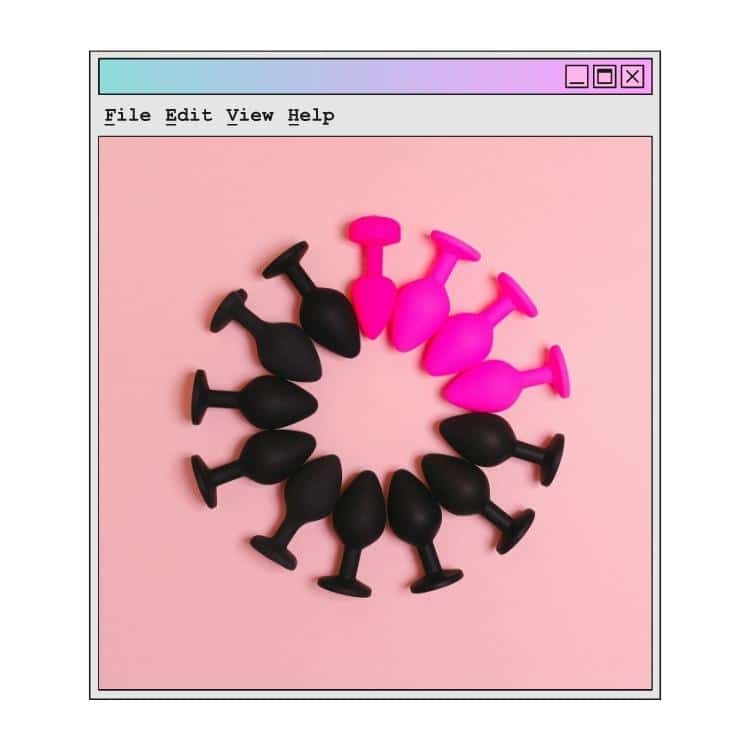
Read the full guide on cleaning anal toys here.
Anal toys, like butt plugs, anal beads or prostate massagers, come into contact with one of the… less fresh areas of your body. That means they need extra special care to keep them clean and safe to use.
First off, check what material your anal toy is made from, and whether it’s waterproof. Then, you can use the soap and water method or the wipe-down method. Be sure to get into every single crevice!
If you want to be extra safe, consider covering your anal toy with a condom before using it. Your clean-up will be way easier, and you’ll protect both the toy and yourself!
Some anal toys can be sterilized, which can be a good idea if you want to share them with another person. Of course, you can only do it if the toy doesn’t contain any electronic parts.
How to Clean a Strap-On
It doesn’t matter who is wearing the strap-on, or who it’s being used on — it still needs a good clean afterward, just like any sex toy!
TLDR: The quick guide
The first thing to do is to separate the dildo and the harness. The dildo can be cleaned in the same way as a regular dildo, keeping in mind the materials it’s made from. If you have a strapless strap-on, you can follow the instructions for dildo or vibrator cleaning, depending on whether it vibrates or not.
How you clean your harness depends on which type of harness it is. Underwear-style harnesses are easy — just stick them in the washing machine like you would regular underwear (but avoid the dryer), or hand-wash them with some laundry detergent. Nylon harnesses are usually also machine-washable, but follow the manufacturer’s instructions.
Leather harnesses are a bit more complex. You can wipe them down with a damp cloth and some saddle soap, and then apply some leather conditioner to keep it soft and supple.
How to Clean a Strap On Dildo With No Electrical Parts
If your strap on doesn’t have any internal motors, it will be waterproof and easy to wash! There are some different techniques depending on whether your strap on dildo is made from a porous or non-porous material. So the first step is to identify which category your dildo falls into.
Non-Porous Materials
- 100% Silicone
- ABS plastic and some other hard plastics
- Glass
- Stainless steel
- Some sealed woods
Porous Materials
- Jelly
- Rubber
- PVC
- TPR/TPE
- Latex
- Own brand realistic skin-like materials (e.g. Fanta Flesh, SuperSkin, etc.)
How to Clean a Non-Porous Strap-on
We always recommend shopping for a strap-on made of a non-porous material as they don’t have any tiny pores for bacteria or germs to hide out in. Silicone strap-ons are the most popular as they are body safe, and are more realistic and flexible than other non-porous materials. As long as your non-porous strap is waterproof and doesn’t have any internal electrics, you also sterilize it for a deep clean! Here are five ways to sanitize (clean) or sterilise your strap-on.
Sex Toy Wipes
This is the least effective method of cleaning a strap-on but sex toy wipes can be a good option when you are in a pinch or for play on the go. I wouldn’t rely on them for your only cleaning method though as they don’t rinse away everything that’s on the toy.
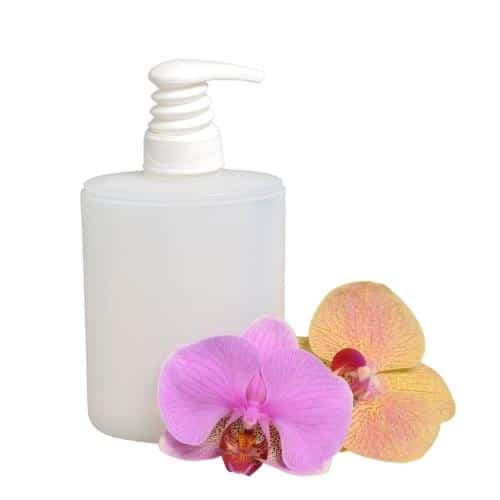
Soap and Water
Good old soap and water! This classic but effective method is great for keeping your strap-on clean. Opt for a fragrance-free soap that won’t be irritating if it accidentally comes into contact with your genitals. Using warm water and soap, make sure to soap up every part of your strap-on, getting into any nooks and crannies. Then rinse the toy clean, ensuring no soap is left on the toy.
Sex Toy Cleaner
Different sex toy cleaners will have different directions, so always check the label for specific instructions. Most sex toy cleaners come in either spray or foam form and need to be rinsed off afterward. I would recommend checking the ingredients for anything you are allergic to and going for a fragrance-free option.

The Dishwasher
Another way to deep clean your non-porous, nonelectrical strap-on is in the dishwasher! Obviously you want to do this in a clean, empty dishwasher and not with your other dishes! It’s also important that you DON’T add soap. If your dishwasher has a sanitize function, use that but if not, you can use a short 5-10 minute wash with a temperature at least 150ºF.
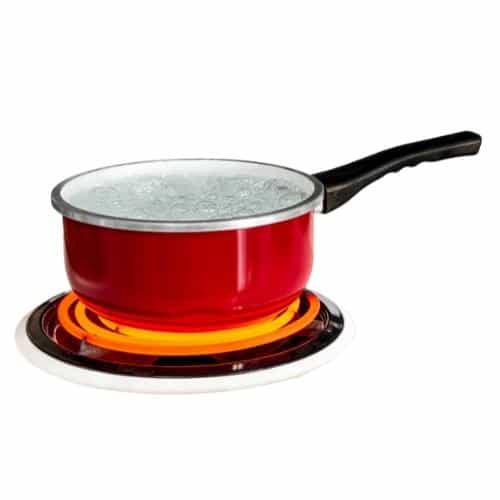
Boil Your Strap-On
Boiling your dildo is a great way to sterilize it completely. Make sure your pan is big enough and then submerge your dildo in boiling water. Let your sex toy soup simmer on a low boil for around 5 minutes. If your strap-on is made from glass or metal, you can place a cloth in the bottom of the pan to stop it from banging against the sides. While it’s not necessary to boil your strap on before every use, it’s good to do it after every few uses.
How to Clean a Porous Strap-on
If your strap-on is made from porous materials, you need to be more careful when cleaning it. Porous materials have tiny holes (pores) that make it impossible to clean fully and germs and mold can grow in these holes over time. Porous materials also degrade much more quickly, so you cannot boil a porous strap-on or put it in the dishwasher.
Stick to Using Soap and Water or a Sex Toy Cleaner
You will want to wash your porous toys with a mild, fragrance-free soap or a sex toy cleaner and warm (not hot) water. Give it a thorough wash and dry it, but be careful not to rub it too vigorously or use a rough towel as this can also damage the material.
Also, you should consider replacing your porous strap-on more often, as you cannot fully clean or sterilize it. If possible, replace it with a non-porous strap-on, as they are much better for you!
Cleaning a Waterproof Strap-On With Electrical Parts
Unfortunately, if your strap-on has electrical parts, like a vibrating strap-on, you cannot boil it or put it in the dishwasher. The extreme heat can damage the mechanics and you don’t want that. Having broken one of my favorite sex toys before, I can tell you now, that it’s heartbreaking!
Here you have some of the same options as above:
- Sex Toy Wipes — Don’t rely on wipes as your only cleaning method, but it’s ok to use them now and again if you cannot clean your strap-on fully.
- Soap and Water — Lather up your strap-on with some mild soap and give a good wash in warm water
- Sex Toy Cleaner — Follow the directions on your sex toy cleaner
What If Your Strap-On Isn’t Waterproof?
If your strap-on isn’t waterproof, you will need to try and prevent any water from getting into the electrical components while also ensuring it gets a good clean.
Take a damp cloth and some mild soap or sex cleaner. Wipe down the toy with a damp cloth and soap or sex toy cleaner. You don’t want to use too much soap as it will be difficult to remove. Then either rinse the soap/cleaner out of the cloth or use a fresh damp cloth to remove all of the soap or sex toy cleaner.
How to Clean Your Harness
Now that you know how to keep your dildo in tip-top condition, let’s look at how to clean the different types of harnesses.
Although your harness won’t get quite as dirty as a dildo, they do soak up all sorts of bodily fluids from both you and your partner, so it’s equally as important to keep it clean between uses.
Here are the different types of harnesses and how to clean them:
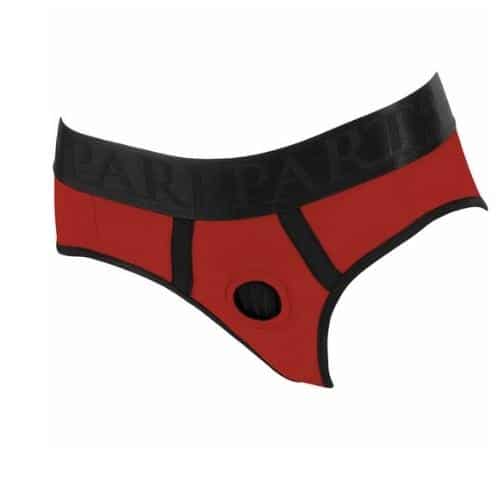
Underwear Style Harnesses
Underwear-style harnesses are the easiest to keep clean as they are pretty much like regular underwear. You have two options when it comes to cleaning underwear-style harnesses:
- Chuck it in the washing machine! Just make sure to follow the washing instructions that came with the harness as different fabrics have different recommended temperatures. I would personally avoid putting it in the tumble dryer as that can weaken the fabric over time.
- Hand wash it. If you use your strap-on more often than you do laundry, you can hand wash it using a suitable laundry detergent and hang it to dry.
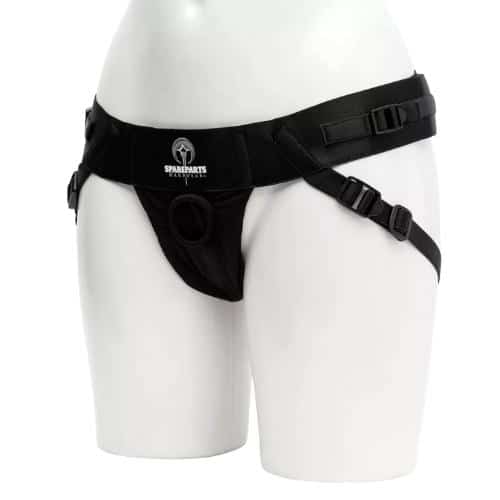
Nylon Strap Style Harness
Most nylon strap-style harnesses are also machine washable, but you should check the manufacturer’s instructions first.
You might also need to remove some pieces, such as O rings, before putting it the washing machine.
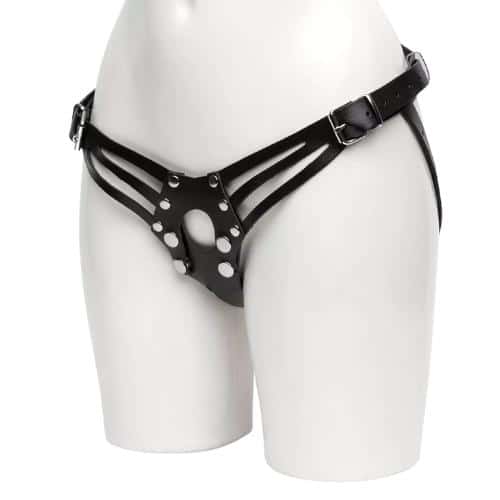
Leather Harnesses
Leather harnesses are the most difficult to care for. As they are porous, it’s a good idea to avoid using a leather harness with multiple partners. Again, you should always check the manufacturer’s guidelines as they are specific to your harness.
- Use a damp cloth and saddle soap to thoroughly wipe the whole harness down. Make sure to remove all of the soap.
- Pat down the harness with a towel and leave it air-dry.
- Use a leather conditioner to replace the moisture lost in the cleaning process and keep the leather supple.
How to Clean a Fleshlight
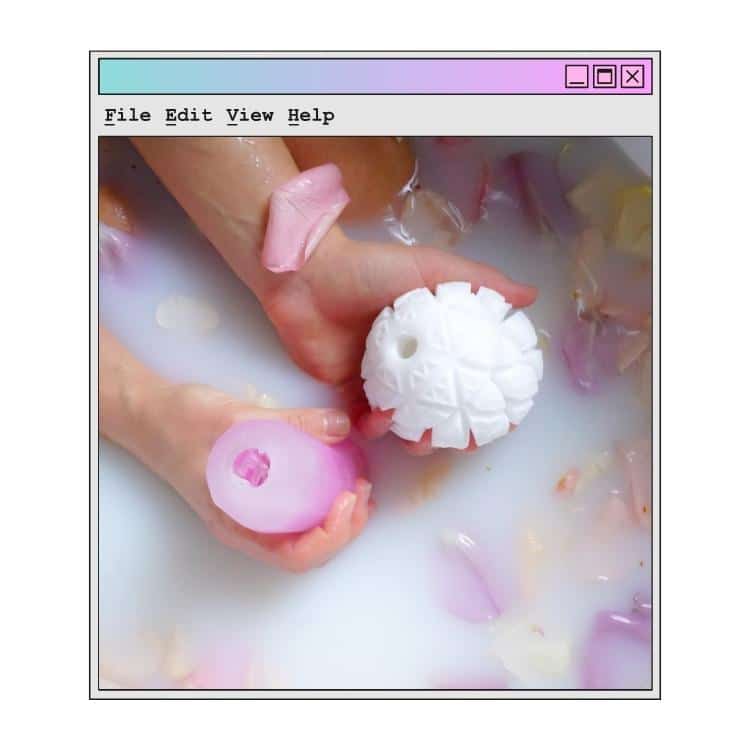
Read the full guide on how to clean a Fleshlight here.
Cleaning a male masturbator sex toy, like a Fleshlight, isn’t the easiest, or fastest, thing in the world. Still, a moist, dark environment like a masturbator sleeve is the perfect place for bacteria and mold to grow, so it’s super important that you learn how to clean it properly!
Plus, Fleshlights, and most other strokers, are made from porous materials like TPE. That means they can harbor all kinds of germs if you’re not careful to clean it after every use.
To clean a Fleshlight, you should remove the sleeve from its case and rinse it through with warm water and mild soap, or a sex toy cleaner like Fleshlight’s own Fleshwash. Make sure to lather up every part of the sleeve (you can even turn it inside out to get into all the crevices), then rinse off all the soap.
Drying your Fleshlight or pocket pussy thoroughly before putting it back in the case is also vital. You can leave it in on a towel in a well-ventilated area for a few hours, or use a Fleshlight drying accessory like the Fleshlight Air or the Hang Dry.
To keep your Fleshlight sleeve feeling soft and realistic, and prevent it from tearing, you can also use renewing powder. Just sprinkle it inside and out until it’s coated in a thin layer, and you’ll feel the difference immediately!
How to Clean a Sex Doll
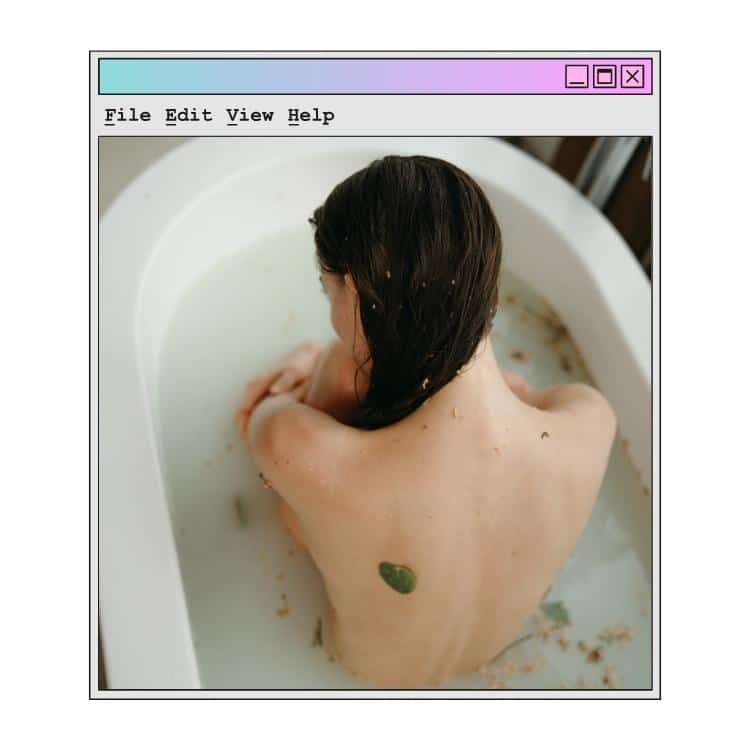
Read the full sex doll care guide here.
As you might imagine, cleaning a sex doll is a bit more of a project than a Fleshlight. The most practical way, if you can lift your doll, is in the bathtub.
Run a warm (not hot) bath with some mild, unscented soap or bubble bath, and place your love doll in it. Make sure the head and neck stay above the water, and gently lather up the body. Alternatively, give your sex doll a sponge bath with soap and water, making sure to rinse it off well when you’re done.
If your sex doll has a vagina, we recommend getting a removable one so that you can clean it just like you would a Fleshlight. However, if it’s not removable, you’ll need to use a sponge, soap, and a vaginal irrigator to clean it out thoroughly.
If your sex doll has a penis, you can clean it in the same way as a dildo! However, if it’s attached, you may find it easier to wipe it down rather than trying to get it under the faucet.
Guide to Sterilizing Sex Toys
Cleaning your sex toys is one of the most important things you can do to protect yourself and your toys!
But, is simply cleaning them enough?
Don’t they need to be sterilized?
Well, that’s what I’m here to help with. I’m going to break down exactly what it means to sterilize your sex toys, explain if and when to do it, and explain exactly how it’s done.
Why Sterilize Sex Toys?
I’m gonna be real with you — you don’t have to be sterilizing your sex toys every time you use them. You don’t even have to be sterilizing them once a week, or even once a month!
Do you want to know the number of times I’ve sterilized my sex toys? Zero. Never.
That’s because I only ever buy and use sex toys made from 100% body-safe, non-porous materials.
I clean them thoroughly with soap and water every time I use them, and I store them in protective storage bags or boxes to stop them from coming into contact with germs and dirt.
With all that being said, there are some situations where you may want to sterilize your sex toys. This could be if…
- Multiple people are using a toy.
- You’re concerned about STIs.
- You haven’t used it in a very long time.
- You didn’t buy it from a very trustworthy place and want to disinfect it before use.
Cleaning vs Sterilizing
So, what is the difference between cleaning sex toys and sterilizing them?
Sex toys can be easily cleaned with some water and mild soap, though how you do it depends on the toy. A simple dildo, for example, can be submerged in water and given a thorough cleaning. On the other hand, some toys are not waterproof, and wiping them down with a little soap on a damp cloth is a better option.
Sterilization is a deeper, more intense process. It actually disinfects your sex toys, making sure all bacteria and germs are killed by heating the toys to a high temperature.
It’s one way to make sure that your sex toys are 100% safe to use, but it’s also much more time-consuming and labor-intensive than just cleaning them. Plus, if you regularly clean your sex toys, you shouldn’t have to disinfect them with every use.
Which Sex Toys Are Sterilizable?
Please, I beg you, don’t just throw any old sex toys in the dishwasher in the hopes of disinfecting them!
Disinfecting and sanitizing sex toys requires very high temperatures and water — not things that every sex toy can handle. Here’s how to tell if your sex toy can be sterilized…
What Type of Sex Toy Do You Have?
This may go without saying, but you can’t boil sex toys with electrical parts in them. That means vibrators, thrusting dildos, automatic masturbators and anything else that can be charged, plugged in or uses batteries. There is one exception to this rule though: if you can remove the electrical element. Some sex toys have bullet vibrators that can be removed, leaving just the non-electrical parts.
You also won’t be able to sterilize very large or bulky sex toys, like sex dolls or sex machines. Some of these kinds of products do come with parts that are removable for cleaning, but not all.
If you’re in doubt, check the instruction manual or website of your sex toy — there’s often guidance on whether or not it can be deep cleaned in this way.
What is Your Sex Toy Made From?
Most of the time, we divide sex toy materials into two categories: porous and non-porous.
Porous materials are, in general, something to be avoided where possible. They contain microscopic holes that can harbor bad stuff like bacteria, fungi and more, which should stay far away from your body. These holes also make them incredibly difficult to properly clean, and they hold onto germs and will break down with high temperatures. Non-porous materials, on the other hand, don’t have these holes and are body-safe.
However, when it comes to sterilizing sex toys, it’s not quite as simple as “boil non-porous toys and don’t boil porous ones!”. There are some non-porous materials, like hard plastic (ABS), are body-safe but will simply melt in the high temperatures needed to sterilize them.
Here’s a guide to which sex toy materials can and can’t be sterilized:
| Sterilizable | Non-Sterilizable |
|---|---|
| 100% Silicone | ABS Plastic |
| Stainless Steel | PVC |
| Borosilicate Glass | TPE/TPR* |
| Vinyl | |
| Jelly | |
| Rubber | |
| Latex | |
| Silicone ‘Blends’ |
Sex toys that are made from crystal, stone or wood can be a bit iffy when it comes to sterilization. Some are sealed with a material that makes them non-porous, but it’s often hard to be 100% sure. I would recommend erring on the side of caution and not boiling these materials.
So, How Do I Sterilize My Sex Toys?
Once you’ve figured out which of your sex toys are safe to be sterilized, you can go ahead with the process. There are two main ways to sterilize sex toys that are safe and effective when done correctly.
Boil Them
Take a large, clean pot of water and allow it to boil. You don’t need to add any soap or other additives — just hot water will do the trick. Once it’s boiling, submerge your sterilization-safe sex toys for 1-3 minutes. If you’re boiling toys made from glass or metal, place them in a mesh laundry bag or add a washcloth to the pot first to protect them as they bounce around.
Stick Them in the Dishwasher
Sterilizing your sex toys in the dishwasher may seem a little intimidating, but it’s pretty simple. Place them on the top rack of your otherwise empty dishwasher, and use a cycle that lasts for 5-10 minutes (and not any longer, they don’t need it!) and reaches at least 150ºF. If your dishwasher has a ‘sanitize’ function, you can select that. Also, don’t add any detergent or soap, as it can leave a residue and harm your genitals.
How NOT to Sterilize Sex Toys
There’s lots of bad (and straight-up dangerous) guidance out there on how you can sterilize your sex toys! As a general rule, I would avoid any other techniques other than the two above.
Keep in mind that whatever you put on your sex toy will likely end up inside you. Even if you rinse off the surface, it’s hard to truly remove every residue — and some substances can cause damage even in very small amounts.
While this is not an exhaustive list, here are some ways NOT to disinfect your sex toys:
- Bleach (or a bleach solution)
- Alcohol
- Hydrogen peroxide
- Windex
What About UV Sanitizers?
You may have heard the growing hype around sex toy storage cases that use UV light to kill germs and sterilize your toys. While these products certainly seem cool, there are some downsides.
First off, it’s unlikely that they’re able to sanitize every part of your sex toys since they can only clean areas where the light can reach. Plus, they’re expensive and very niche. A thorough clean with water and mild soap, and storing your toy in a protective pouch or box is perfectly adequate.
Cleaning Sex Toys With a Dishwasher: Does It Actually Work?
Yes, cleaning sex toys with a dishwasher does work (and it’s quite simple!).
After your toy has been cleaned off, you simply place your sex toy(s) in the dishwasher, turn it to “sanitize”, and run it through the cycle.
Easy enough, right?
Well, while this method might work fine for you, there’s also a chance that you’ll completely ruin your sex toy…
No good!
Keep reading to learn:
- How to tell if your toy is dishwasher-safe
- If using the dishwasher is worth it, &
- Methods for effectively cleaning any type of sex toy!
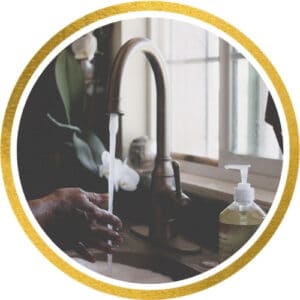
Different Types of Toys
There are many different types of sex toys. Consequently, there are many different types of materials used to make these toys. When trying to figure out whether you can clean your favorite toys in the dishwasher, you’ll first need to determine what materials your toy is made of. The sections below will help you categorize your toy.
Non-Porous
Non-porous materials are dishwasher-safe. The term “non-porous” means that these materials don’t have pores in them (unlike porous toys). Since they don’t have any pores for bacteria to hide in, they can be sanitized and even completely sterilized with the right methods! This makes them ideal materials for internal-use sex toys like dildos or anal beads.
For better or for worse, there aren’t many non-porous sex toy materials. This somewhat limits your options when shopping, but it also makes it easy to remember which materials are non-porous! Your sex toy is non-porous if it’s made from:
- Medical-grade silicone
- Metal (such as stainless steel) – look for brands like nJoy
- Borosilicate glass – look for brands like Icicles
- ABS plastic
Porous
If your sex toy is made from any material other than the ones that are listed above, chances are, it’s porous! Common porous sex toy materials include TPE, PVC, “Jelly”, leather, and “silicone blends”. Porous materials are generally cheaper, making them popular for budget-friendly sex toys. However, these savings come at a price: you can’t sanitize or sterilize porous materials!
Not all is lost though: porous toys can still be safe to use. If safety is your top concern then we’d recommend using a condom with your porous sex toys. This will help protect you from any bacteria hiding within the pores of the material. To use (or not use) a condom is up to you, but you should always try to avoid toys with phthalates. If it’s not labeled “phthalate-free”, it’s not body-safe!
A Dishwasher-safe Sex Toy Will Be…
✓ Non-porous
✓ Completely waterproof
✓ Free of electrical components
Common Toy Types You Can Clean in the Dishwasher
- Silicone dildos
- Silicone cock rings
- Butt Plugs
- Anal Beads
“Waterproof” Vs. “Splashproof”
The dishwasher method only works with non-porous materials. If you’ve determined that your toy is non-porous, you’ll next need to figure out its water resistance level. There are three common levels: not waterproof, “splashproof”, and “waterproof”. The first level is self-explanatory, but the latter two can be confusing!
Splashproof toys can be briefly exposed to water. However, they’re not designed for complete immersion and will likely fail if held underwater. These toys aren’t even shower-safe: keep them out of the dishwasher!
Waterproof toys are just that: waterproof! Since they are designed to be used underwater, meaning they’re just as effective in the bathtub as they are in bed. Some shower toys are manually operated, meaning they don’t rely on internal electronics (like a regular dildo). Those types of toys can be washed in the dishwasher!
However, if your toy contains internal electronics (like a vibrating dildo), you should keep it out of the dishwasher. Sure, the silicone exterior might survive the heat of the dishwasher, but the internal electrical components likely won’t fare as well. Skip the dishwasher, and try one of the methods mentioned below instead.
Using the Dishwasher
- Make sure your toy(s) are dishwasher-safe.
- Remove any other items that are currently in your dishwasher (you’ll be washing the sex toys alone).
- Skip adding soap, since this will leave unnecessary and potentially harmful residue.
- Place your toys on the top rack in your dishwasher.
- Set the dishwasher to “Sanitize” (or similar mode with water temperatures exceeding 150º F).
- Remove your toy(s) after 10 minutes.
- Make sure your toys are properly dried before storing them away.

